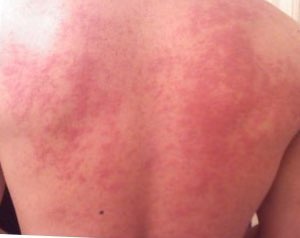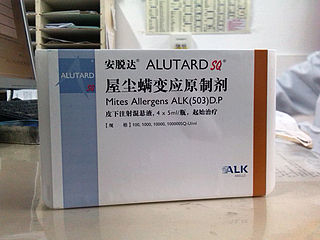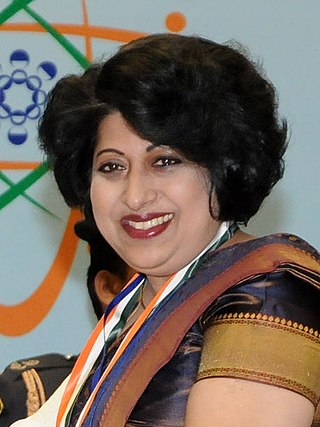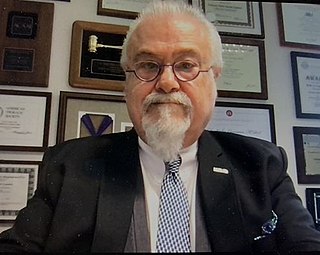
Allergies, also known as allergic diseases, are various conditions caused by hypersensitivity of the immune system to typically harmless substances in the environment. These diseases include hay fever, food allergies, atopic dermatitis, allergic asthma, and anaphylaxis. Symptoms may include red eyes, an itchy rash, sneezing, coughing, a runny nose, shortness of breath, or swelling. Note that food intolerances and food poisoning are separate conditions.
Anaphylaxis is a serious, potentially fatal allergic reaction and medical emergency that is rapid in onset and requires immediate medical attention regardless of the use of emergency medication on site. It typically causes more than one of the following: an itchy rash, throat closing due to swelling that can obstruct or stop breathing; severe tongue swelling that can also interfere with or stop breathing; shortness of breath, vomiting, lightheadedness, loss of consciousness, low blood pressure, and medical shock. These symptoms typically start in minutes to hours and then increase very rapidly to life-threatening levels. Urgent medical treatment is required to prevent serious harm and death, even if the patient has used an epipen or has taken other medications in response, and even if symptoms appear to be improving.

A food allergy is an abnormal immune response to food. The symptoms of the allergic reaction may range from mild to severe. They may include itchiness, swelling of the tongue, vomiting, diarrhea, hives, trouble breathing, or low blood pressure. This typically occurs within minutes to several hours of exposure. When the symptoms are severe, it is known as anaphylaxis. A food intolerance and food poisoning are separate conditions, not due to an immune response.

Omalizumab, sold under the brand name Xolair, is an injectable medication to treat severe persistent allergic forms of asthma, nasal polyps, urticaria (hives), and immunoglobulin E-mediated food allergy.

Allergen immunotherapy, also known as desensitization or hypo-sensitization, is a medical treatment for environmental allergies, such as insect bites, and asthma. Immunotherapy involves exposing people to larger and larger amounts of allergens in an attempt to change the immune system's response.

Soy allergy is a type of food allergy. It is a hypersensitivity to ingesting compounds in soy, causing an overreaction of the immune system, typically with physical symptoms, such as gastrointestinal discomfort, respiratory distress, or a skin reaction. Soy is among the eight most common foods inducing allergic reactions in children and adults. It has a prevalence of about 0.3% in the general population.

Milk allergy is an adverse immune reaction to one or more proteins in cow's milk. Symptoms may take hours to days to manifest, with symptoms including atopic dermatitis, inflammation of the esophagus, enteropathy involving the small intestine and proctocolitis involving the rectum and colon. However, rapid anaphylaxis is possible, a potentially life-threatening condition that requires treatment with epinephrine, among other measures.

A tree nut allergy is a hypersensitivity to dietary substances from tree nuts and edible tree seeds causing an overreaction of the immune system which may lead to severe physical symptoms. Tree nuts include almonds, Brazil nuts, cashews, chestnuts, filberts/hazelnuts, macadamia nuts, pecans, pistachios, shea nuts and walnuts.

Ruby Pawankar has been president of the World Allergy Organization (WAO), 2012 and 2013. She is the first Indian and first woman president of WAO, which was established in 1951. Currently she is past president, WAO, president of the Asia Pacific Association of Allergy Asthma and Clinical Immunology (APAAACI) and council member of Collegium Internationale Allergolicum (CIA). She is professor of allergy, department of pediatrics at Nippon Medical School in Tokyo, Japan, and guest professor at Showa University School of Medicine, Tokyo, Japan, Kyung Hee University School of Medicine, Seoul, Korea and St. John's Medical College, Bengaluru, India. She is a recipient of Pravasi Bharatiya Samman 2010 for excellence in medicine, from the president of India.
Torsten Zuberbier is a German dermatologist and allergologist.
Igor Petrovych Kaidashev is a Ukrainian immunologist and allergist, MD, and Professor. Igor Kaidashev is President of the Ukrainian Society of Immunology, Allergy and Immunorehabilitation, Professor of the Department of Internal Medicine No. 3 with Phthisiology, and Vice-Rector for Research & Development at Poltava State Medical University (PSMU) since 2010.

Alain L. de Weck,, was a Swiss immunologist and allergist. His main scientific contributions were in the area of characterization and prevention of drug allergy. He was the founding director of the Institute of Clinical Immunology at the University of Bern from 1971 to 1993 and authored or co-authored over 600 peer-reviewed publications. He is the recipient of a number of patents that led to commercial allergy products and services. He served as president of international scientific organizations such as the International Union of Immunological Societies (IUIS) and the International Association for Allergy and Clinical Immunology (IAACI) and was founder and later CEO of the Centre Médical des Grand-Places (CMG) company, acquired by Heska of Fort Collins in 1997. In later years he continued his research at the University of Navarra in Spain and wrote on a wide range of topics such as the distinction between science and pseudo-science, the emergence of genetically modified organisms (GMOs) and comparative health care policy.
Mast cell activation syndrome (MCAS) is a term referring to one of two types of mast cell activation disorder (MCAD); the other type is idiopathic MCAD. MCAS is an immunological condition in which mast cells inappropriately and excessively release chemical mediators, resulting in a range of chronic symptoms, sometimes including anaphylaxis or near-anaphylaxis attacks. Primary symptoms include cardiovascular, dermatological, gastrointestinal, neurological and respiratory problems.
Oral mite anaphylaxis (OMA), also known as pancake syndrome, is a disease in which a person gets symptoms after eating food contaminated with particular mites. The disease name comes from reports of people becoming ill after eating pancakes made from contaminated wheat or corn (maize) flour.

Riccardo Polosa is an Italian respiratory physician. According to a paper published in BMC Public Health, he is the most prolific author in the field of electronic cigarettes, as of 2014. "Full Professor of Internal Medicine and specialist of Respiratory Diseases and Clinical Immunology at the University of Catania as well as the Founder and Clinical Director of the Center for Tobacco Research and Scientific Director of the Center of Excellence for the acceleration of Harm Reduction (CoEHAR) at the same University." His research interests center on asthma, COPD, respiratory diseases, smoking-related diseases, smoking prevention and cessation, tobacco harm reduction, and new tobacco products. Since 2009, his research team has been involved in studies on the impact of e-cigarettes, and they were the first in the world to publish a randomized controlled trial on e-cigarettes.
Exercise-induced anaphylaxis is a rare condition in which anaphylaxis, a serious or life-threatening allergic response, is brought on by physical activity. Approximately 5–15% of all reported cases of anaphylaxis are thought to be exercise-induced.

Andrii Ihorovych Kurchenko is a Ukrainian dermatologist, immunologist and allergologist, Doctor of Sciences in Medicine, Professor, head of department of Clinical Immunology and Allergology at O.Bohomolets National Medical University. He is an Expert of the Scientific and Expert Council at the State Expert Center of the Ministry of Health of Ukraine, a Fellow of the European and American Academies of Allergology and Clinical Immunology and Vice-President of the Ukrainian Society of experts in Immunology, Allergology and Immune rehabilitation (UTIAI). He is Deputy-editor of the journal "Immunology and Allergology. Science and Practice", as well as a co-author of the national textbooks "Clinical and Laboratory Immunology" (2012) and "Immunology" (2013).

Giorgio Walter Canonica is an Italian allergist, pulmonologist and professor of Respiratory Medicine at Humanitas University, Milan, Italy and Director Personalized Medicine Asthma & Allergy Center at Humanitas Research Hospital IRCCS-Milano Italy since December 2016. He is known for his research work related to innovative treatment strategies for allergic diseases which includes biological response modifier in form of targeted immunotherapy with primary emphasis on sublingual immunotherapy (SLIT). He has served as Secretary General and President elect of World Allergy Organisation for six consecutive years and has served as president of the same organization during 2007–09. He is also the vice-president of INTERASMA.
Mimi Tang is an Australian immunologist allergist specialized in food oral immunotherapy, such as pairing exposure to peanut proteins with probiotics.












